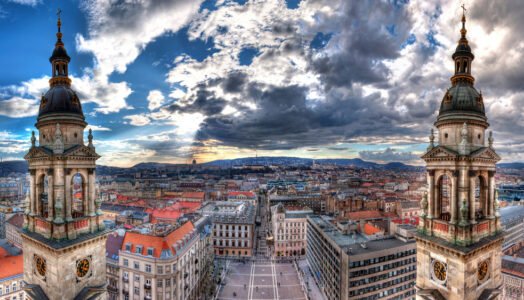a formerly communist central European country bounded by Austria, Slovakia, Ukraine, Romania, Serbia and Croatia. The capital city is Budapest; other major centers include Debrecen, Miskolc, Pécs, Szeged, and Győr. Hungary adopted a new constitution in 2012 which recognizes that life begins at conception, though it continues to have a higher abortion rate than the United States – but falling. Hungary has adopted socially conservative laws in recent years.
Geography
Hungary is landlocked and mainly forms a low-lying plain; it is crossed by the rivers Danube (Duna) and Tisza. The west of the country includes the large Lake Balaton, on the shores of which a number of resort towns are situated.
- Area: 93,030 km2. (35,910 sq. mi.); about the size of Indiana.
- Cities: Capital—Budapest (est. pop. 2 million). Other cities—Debrecen (220,000); Miskolc (208,000); Szeged (189,000); Pécs (183,000).
- Terrain: Mostly flat, with low mountains in the north and northeast and north of Lake Balaton.
- Climate: Temperate.
People
Ethnic groups in Hungary include Magyar (nearly 90%), Roma, German, Serb, Slovak, and others. The majority of Hungary’s people are Roman Catholic; other religions represented are Calvinist, Lutheran, Jewish, Baptist, Adventist, Pentecostal, and Unitarian. Magyar is the predominant language.
- Nationality: Noun and adjective–Hungarian(s).
- Population (July 2007 est.): 9,956,108.
- Ethnic groups: Magyar 89.9%, Roma 4% (est.), German 2.6%, Serb 2%, Slovak 0.8%, Romanian 0.7%.
- Religions (2001 census): Roman Catholic 51.9%, Calvinist 15.9%, Lutheran 3%, Greek Catholic 2.6%, Jewish 1%, others, including *Baptist Adventist, Pentecostal, Unitarian 3%.
- Languages: Magyar 98.2%, other 1.8%.
- Education: Compulsory to age 16. Attendance—96%. Literacy—99.4%.
- Health (2007 est.): Infant mortality rate—8.21/1,000. Life expectancy—men 68.73 yrs., women 77.38 yrs.
- Work force (2006 est., 4.21 million): Agriculture—5.5%; industry and commerce—33.3%; services—61.2%.
In Hungary, the official orthography is the Latin-based Hungarian alphabet, albeit, the earlier Szekely-Hungarian Rovas and the Carpathian Basin Rovas are also used sporadically.
Government & Political Conditions
The president of the republic, elected by the National Assembly every 5 years, has a largely ceremonial role, but powers also include appointing the prime minister. The prime minister selects cabinet ministers and has the exclusive right to dismiss them. Each cabinet nominee appears before one or more parliamentary committees in consultative open hearings and must be formally approved by the president. The unicameral, 386-member National Assembly is the highest state authority body and initiates and approves legislation sponsored by the prime minister. A party must win at least 5% of the national vote to form a parliamentary faction. National parliamentary elections are held every 4 years (the last in April 2006). A 15-member Constitutional Court has power to challenge legislation on grounds of unconstitutionality.
Principal Government Officials
- President: János Áder
- Prime Minister: Viktor Orbán
- Minister of Foreign Affairs: János Martonyi
- Ambassador to the United Nations: Gábor Bródi




